Trekabout Photography Workshops - Creating Adventure Through Photography
Workshops, Tours, Adventures with Accredited Professional Photographer Mark Rayner and the Dream Team
Where: Namibia - AFRICA
Book now to secure your spot on this amazing photography workshop and tour.
Bookings at the bottom of this page.
Please check back for additional dates. If you subscribe to the TREKeZine RSS feed, you will be automatically notified when more workshop dates are released.
QUESTIONS? EMAIL US HERE
Please join Australian professional wildlife photographer Mark Rayner and the Namibia's most reputable and well-known naturalist safari guides guides on an amazing photography journey of a lifetime in Africa.
This is the ultimate Namibia photographic safari.
Join Mark and superb naturalist guides exploring the beautiful landscapes of Namibia staying in great camps, lodges and even mobile camping on our very own exclusive site with the stars above you!
You'll meet Himba, track desert elephant, rhino and more whilst on the mobile safari not to mention fly over the Sossusvlei region in helicopter (optional) for that bird's eye perspective.
So why Namibia I hear you say?
Namibia is a vast country, even by African standards, covering an area approximately four times the size of the United Kingdom but with a population of a mere 2 million - one of the lowest densities in the world. It is also an 'ageless land’; visible through its heritage of rock art created by stone-age artists and geological attractions such as the petrified forest where fossilised tree trunks have lain for over 280 million years.
Added to the space and silence, these all contribute to a feeling of antiquity, solitude and wilderness.
The climate is typical of a semi-desert country. Days are warm to hot and nights are generally cool. Temperatures are modified by the high plateau in the interior and by the cold Benguela Current that runs along the Atlantic coastline. Except for the first few months of the year, the country is generally dry with very little rain.
This private guided safari affords you the chance to experience this magnificent and memorable country in a very personal way. You will have your own professional and experienced safari guide who will enhance your enjoyment of this unique country by making it a fascinating and stress-free journey of discovery amidst very dramatic scenery.
The knowledge, experience and attitude of our guides are critical to a successful safari, which is why we ensure that they are both personable and very professional.
Your guide will have an intimate knowledge of each area and camp/lodge that you visit, allowing them to share the local highlights whilst adding continuity and depth to your safari. It goes without saying that they know exactly what a "True African Safari" is all about. Not only are our guides highly qualified, each has a specific area of expertise. Together they possess the breadth and depth of knowledge to allow them to answer questions and satisfy the particular interests of each of our guests. Your guide will turn your safari into an experience of a lifetime!
Itinerary and Program of Events
After landing at Windhoek International (Hosea Kutako) Airport, located about 40km outside the city, you will be met and greeted by our safari representative who will transfer you into town to the Galton House where you will stay overnight in their beautifully designed rooms. The rest of the day is at leisure to relax and recuperate from your flight. Your guide will come to meet you to brief you on any administrative arrangements and answer any questions you may have about the program, before taking you out to dinner, either at your hotel or out at one of the popular restaurants in town. Welcome to Namibia!
Windhoek Capital City: Windhoek, Namibia’s capital nestles among rolling hills, bounded by the Eros Mountains in the east, the Auas Mountains to the south and the Khomas Hochland in the west. It is a meeting place between Africa and Europe, the modern and the old. In the capital’s main street, well-preserved German colonial buildings are in sharp contrast with modern architectural styles, while Herero women in their traditional Victorian dresses mingle with executives dressed in the latest fashions. Centrally located within Namibia, Windhoek is an excellent starting point for an adventurous holiday for many visitors to the country and an ideal base from where to explore the rest of the country.
Villa Vista is an upmarket accommodation establishment situated in a quiet neighbourhood close to the Windhoek city centre (approx. 1.2km). Being well situated makes it a true home hidden in the big city life. All the rooms are individually decorated in a unique style, using wood, glass, candles and natural elements. Looking out over the garden, swimming pool, town, western mountains and afternoon sunsets, the open terrace offers a romantic and peaceful experience. Facilities include a sauna, swimming pool, gym and free Wi-Fi service provides the luxury of being able to finish-off some last minute work and send emails. A laundry service is available on request.
Drive Windhoek to Quivertree Forest Rest Camp
After breakfast this morning we depart Windhoek for the start of your safari.
You set off south along the western side of the Kalahari Desert past Rehoboth and Mariental and then on to stay at the Quivertree Forest Rest Camp on the outskirts of Keetmanshoop. Lunch will be enjoyed at a scenic location en route. From here you will have the perfect base from which to photograph Quiver trees & Giants Playground at different light intensities.
Overnight: Quivertree Forest Rest Camp
Quivertree Forest:
A popular subject for photographers, the Quivertree Forest harbors around 300 Quiver Trees (Aloe dichotoma), also referred to by its Afrikaans name Kokerboom. Actually an aloe plant rather than a tree, these attractive succulents reach skywards with graphically forked branches, splitting into pairs, hence the name ‘dichotoma’. The Quiver Tree is one of the most interesting and characteristic plants of Namibia are very hot and dry southern regions. The name Quiver Tree refers to the traditional use of the branches by Bushmen and Hottentots tribes to make quivers for their arrows. On average the trees are about 3m to 5m tall (reaching up to 9m in height) and can be up to one meter in diameter at ground level. The larger trees in the forest are around 200 to 300 years old. They produce bright yellow flowers during the winter months (June and July) and their trunks are smooth and shiny with light creamy to silvery-grey bark which peels and forms intricate rectangular and diamond-shaped patterns as the tree matures. The Quiver Tree mostly occurs in black rock formations (dolerite), needed to anchor the plants which have a shallow spread root system.
Giants Playground:
Across the road from the Quiver Tree Forest is the Giants Playground, an impressive jumble of dolerite boulders which are roughly 180 million years old. It’s called the Giant’s Playground because of the way the massive dolerite boulders are placed on top of each other like a giant’s building blocks. Molten magma pushed its way through fissures in the underlying rock, creating dolerite dykes that have since been exposed as the surrounding sedimentary rock has eroded, leaving the harder dolerite boulders to undergo further weathering into the bizarre formations we see today. Wandering through the maze of boulders is fascinating, but care must be taken not to become lost in the extensive rocky labyrinth.
Quiver Tree Forest Rest Camp: Visit the wonders of nature and relax at the close-by rest camp, a family farm lived on by 3 generations. The camp consists of eight rooms with private shower, toilets and air-conditioning and seven fully equipped self-catering bungalows. A camp site is also present with electricity, hot showers and toilets. All visitors are welcome to visit the Quiver Tree Forest and Giant’s playground as well as attend the daily cheetah feeding.






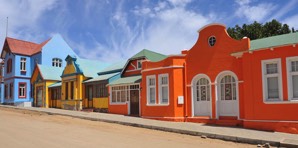

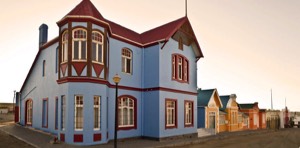
Day 3 - Luderitz - Kolmanskop
Quivertree Forest Rest Camp - Luderitz
This morning you have the option of rising early to experience the sunrise over the Quivertree Forest. After breakfast and freshening up, you take to the road heading southwest towards the coast, passing through the towns of Seeheim and Aus keeping a lookout for the legendary feral desert horses along the way from Aus.
This afternoon your guide will arrange for you to visit the ghost town of Kolmanskop. Stepping back in time, you will have the opportunity to explore the desolate streets and abandoned buildings and photograph this fascinating site before returning to Lüderitz (non-commercial photographic permit included).
Overnight: Luderitz Nest Hotel
Luderitz
Sandwiched between the rugged and stark Atlantic Coast and the arid desert of Namibia, the town of Luderitz is located in an incredible unique geographical setting. This seaside town is something of an anomaly frozen in time – a piece of 19th-century Bavaria bordering the pinkish sand dunes of the Namib Desert. Lutheran churches, German bakeries, and colonial buildings boasting German art nouveau architecture are dotted about the settlement, while its windswept beaches are home to flamingos, ostriches, seals, and penguins. The nearby ghost town of Kolmanskop, which has been taken over by the desert dunes, is another fascinating must-see attraction, located approximately 10 kilometres from Luderitz central, along with the herd of wild desert-adapted horses near the small town of Aus.
Kolmanskop Ghost Town: Namibia’s most famous ghost town, Kolmanskop, was named after a transport driver called Johnny Coleman, who lived in the settlement of Aus at the turn of the century. During a strong sandstorm he was forced to abandon his ox wagon on the small incline from where Kolmanskop can be seen. It stood there for a while; giving rise to the name Colemanshuegel, which eventually became Kolmanskop. In 1908 railway worker Zacharias Lewala found a sparkling stone amongst the sand he was shoveling away from the railway line near Kolmanskop.
August Stauch, his supervisor, was convinced he had found a diamond. When this was confirmed, the news spread like wildfire, sparking a frantic diamond rush, and causing fortune hunters to converge in droves on Kolmanskop. It soon became a bustling little center with butchery, bakery, furniture factory, soda water and lemonade plant, four-skittle bowling alley, a public playground and even a swimming pool. The town’s development reached its pinnacle in the twenties, with approximately 300 German adults, 40 of their children and 800 Owambo contract workers living there. Despite, or probably because of, the isolation and bleakness of the surrounding desert, Kolmanskop developed into a lively little haven of German culture, offering entertainment and creation to suit the requirements of the affluent colonialists for whom large, elegant houses were built. The well-equipped hospital boasted southern Africa’s first x-ray machine. However, when richer diamond deposits were discovered further south, operations were moved to Oranjemund. Today the ghost town’s crumbling ruins bear little resemblance to its former glory but offer numerous attractive themes for photography.
The stately homes, their grandeur now scoured and demolished by the wind, are gradually becoming overrun with sand. In 1980 the mining company CDM (now Namdeb) restored several of the buildings and established a museum for visitors. On a guided tour through the Ghost Town, you will learn more about everyday life in the settlement and about its rise and fall.



Day 4 - Luderitz - Kolmanskop
Kolsmanskop
This morning you head out to visit Kolmanskop before having a wonderful lunch back in town before exploring the town of Lüderitz on foot and then head back to Kolmanskop for an afternoon photo session, returning to the hotel shortly after sunset. Dinner tonight will be enjoyed back at your hotel or out in town with your guide at one of the popular restaurants.
Overnight: Luderitz Nest Hotel



Day 5 - Sesriem
Drive Luderitz to Sossusvlei
This morning you head out to Kolmanskop early enough to set up your equipment in time to see the sun rise and to capture the dunes and remnants of yesteryear at best light once more. You then leave the coast and Lüderitz behind as you make your way north into the Namib Desert. From Aus you head north through the spectacular scenery of the Tiras Mountain Conservancy and a section of the NamibRand Nature Reserve before entering the Namib Naukluft National Park to reach Dead Valley Lodge in the late afternoon, stopping for scenic photo shoots along the way.
Here you will stay for two nights whilst you explore the remarkable sights of the Namib Desert with your guide. Dead Valley Lodge is one of only two lodges that affords you prime location within the boundaries of the Namib Naukluft National Park. If there is still time today, your guide will take you to visit Sesriem Canyon, a nearby geological attraction, or explore Elim Dune. However, if you prefer, you can just relax and soak in the scenic and tranquil surroundings at Dead Valley Lodge or head out on a photographic excursion.
Overnight: Dead Valley Lodge
Sossusvlei:
This most frequently visited section of the massive 50,000 km² Namib Naukluft National Park has become known as Sossusvlei, famous for its towering apricot coloured sand dunes which can be reached by following the Tsauchab River valley. Sossusvlei itself is actually a clay pan set amidst these star shaped dunes which stand up to 300 meters above the surrounding plains, ranking them among the tallest dunes on earth. The deathly white clay pan contrasts against the orange sands and forms the endpoint of the ephemeral Tsauchab River, within the interior of the Great Sand Sea. The river course rises south of the Naukluft Mountains in the Great Escarpment. It penetrates the sand sea for some 55 km before it finally peters out at Sossusvlei, about the same distance from the Atlantic Ocean. Until the encroaching dunes blocked its course around 60,000 years ago, the Tsauchab River once reached the sea; as ephemeral rivers still do in the northern half of the Namib. Sand-locked pans to the west show where the river previously flowed to before dunes shifted its endpoint to where it currently gathers at Sossusvlei.
Roughly once a decade rainfall over the catchment area is sufficient to bring the river down in flood and fill the pan. On such occasions the mirror images of dunes and camel thorn trees around the pan are reflected in the water. Sossusvlei is the biggest of four pans in the vicinity. Another, famous for its gnarled and ghostly camel thorn trees, is Deadvlei which can be reached on foot over 1 km of sand. Deadvlei’s striking camel thorn trees, dead for want of water, still stand erect as they once grew. They survived until about 900 years ago when the sand sea finally blocked the river from occasionally flooding the pan.
Sesriem Canyon:
Sesriem Canyon has evolved through centuries of erosion by the Tsauchab River which has incised a narrow gorge about 1.5km long and 30m deep into the surrounding conglomerates, exposing the varying layers of sedimentation deposited over millions of years. The shaded cool depths of the canyon allow pools of water to gather during the rainy season and remain for much of the year round. These pools were a vital source of water for early settlers who drew water for their livestock by knotting six (SES) lengths of rawhide thongs (riems) together, hence the canyon and surrounding area became known as Sesriem.


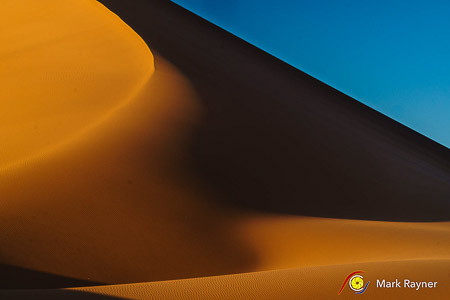



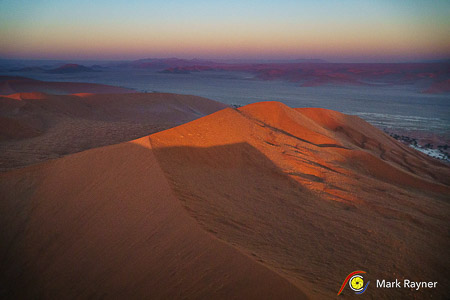
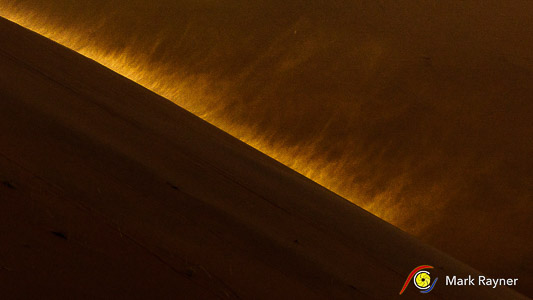

Namib Naukluft Park / Sossusvlei
Today will be full of photography as you rise early in the morning for magical excursion into the dunes with your guide. As you are already inside the park you can get into Sossusvlei before everyone else and you would even be able to get there in time to see the sun rise to capture the dunes whilst the light is soft and shadows accentuate their towering shapes and curves. This area boasts some of the highest free-standing sand dunes in the world. Your guide will give you an insight on the formation of the Namib Desert and its myriad of fascinating creatures and plants that have adapted to survive these harsh environs. Once you have explored the area to your heart’s content you can enjoy a relaxed picnic breakfast in the shade of a camel thorn tree. You then return to Dead Valley Lodge in time for lunch. The rest of the afternoon will be at your leisure (from experience, this is usually welcomed after an exhilarating morning in the dunes) with the option to head out again later in the afternoon to visit the dunes at Sossusvlei to see them whilst the shadows sharpen as the sun goes down or the beautiful Sesriem Canyon with its rocky formations and caverns.
Overnight: Dead Valley Lodge
Day 7 - Swakopmund
Drive Sossusvlei to Swakopmund
The fascinating drive today takes you northwest through the breathtaking and ever-changing desert landscapes of the Namib Naukluft National Park, including the impressive Gaub and Kuiseb canyons. You meet the coast at the port town of Walvis Bay where you have the option to visit the lagoon to see the interesting mix of pelicans, flamingos, and other sea birds, before continuing to your hotel in Swakopmund. There will be time this afternoon to wander around town and along the waterfront on foot if appeals, before heading out to dinner at one of the popular restaurants in town with your guide.
Overnight: Strand Hotel
Day 8 - Swakopmund
This morning is at leisure and can either be spent relaxing at your hotel, exploring the town of Swakopmund before heading to the harbour town of Walvis Bay from where you will embark on an afternoon sunset excursion to discover the beautiful Sandwich Harbour area with plenty of photographic stops along the way. You will enjoy some beverages and snacks whilst enjoying a beautiful sunset from the top of one of the higher dunes in the area before returning to Walvis Bay where you will meet up with your guides and head to dinner at a local restaurant in Walvis Bay or Swakopmund with your guide.
Overnight: Strand Hotel
Walvis Bay: Walvis Bay is Namibia’s main Port town as well as being the base for a variety of fishing and recreational activities on the Lagoon and out at sea. The town is less of a seaside resort than Swakopmund, but it has a variety of areas that are of specific interest especially to birders, including the Lagoon itself and the area around the salt works on the way out towards Pelican Point. The Port was a British Protectorate during the years that Southwest Africa was a German Colony and did not immediately become part of Namibia after Independence. In fact, it took almost another five years before that happened.
Sandwich Harbour: Sandwich Harbour is located approximately 80 km south of Swakopmund, beyond the town of Walvis Bay. It is a remarkably beautiful attraction that consists of a lagoon lying between the Atlantic Shore and high
dunes of the Namib sand sea. It is a Ramsar wetland site of international importance and is also known to be one of the best spots for birding at the coast. Sandwich Harbour is best explored with a local guide who is skilled in off-road driving as the route to the Harbour has no road and crosses the dunes.
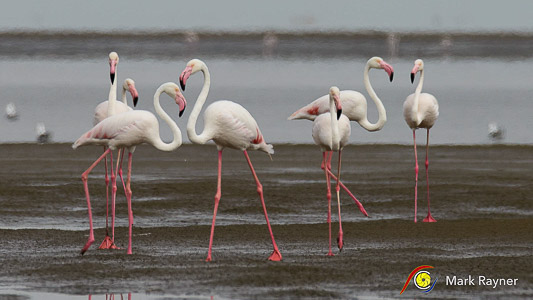
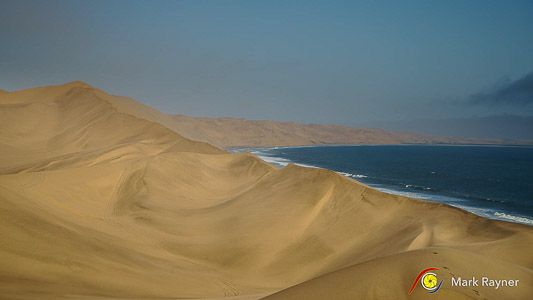










Continuing your safari today, the road takes you north along the coastal road passing by the haunting remains of the Zeila shipwreck and you then head east into the wonderful and diverse region of Damaraland, taking time to view game and absorb the vastness of the scenery along the way. Damaraland is typified by displays of colour, magnificent table topped mountains, rock formations and bizarre-looking vegetation. The present-day landscape has been formed by the erosion of wind, water and geological forces which have formed rolling hills, dunes, gravel plains and ancient river terraces. It is the variety and loneliness of the area as well as the scenic splendour which will reward and astound you, giving one an authentic understanding of the word 'wilderness'.
Later this afternoon and If time allows your guides will take you to visit the nearby attractions and geological sites of the pre-historic Twyfelfontein rock engravings (a UNESCO World Heritage Site) - if not there is plenty of time to see them tomorrow.
Overnight: Doro Nawas
Twyfelfontein: Strewn over a hillside amongst flat-topped mountains of red sandstone, Twyfelfontein’s boulders and slabs of red sandstone hold some 2,500 prehistoric engravings that depict wildlife, animal spoor and abstract motifs. It is perhaps the largest and finest collection of petroglyphs in Africa. The engravings show animals such as elephant, giraffe, kudu, lion, rhinoceros, springbok, zebra and ostrich that once used to drink from a fountain at the bottom of the hill. In some cases footprints were engraved instead of hooves or paws. The abstract motifs feature mainly circles. Stone tools and other artifacts found at Twyfelfontein suggest that hunter-gatherers occupied the site over a period of perhaps 7,000 years. These days a local guide accompanies visitors to showcase the rock art. The engravings lie along two circular routes, one an hour’s climb and the other 40 minutes longer. Twyfelfontein is one of Namibia’s key National Monuments and is also a UNESCO World Heritage Site.
Doro! Nawas: Doro !Nawas lies on a small hill overlooking ancient plains, with unspoilt panoramic views of a diverse and dramatic landscape. Natural walled units have a unique design and décor that complement the surrounding scenery, with attention to comfort and luxury in the semi- arid desert conditions. All units have a private bedroom leading out onto a veranda, and en-suite facilities with both indoor and outdoor showers, basins and flush toilet. The main area has indoor and outdoor dining areas, a pool area, bar and leads to a small art gallery. The rooms have beds on rollers so that they can be pulled outside onto the deck, thus allowing guests to sleep 'outside' if they wish. There is also a roof top seating area on top of the restaurant which is ideal for panoramic photography by day as well as star gazing at night.
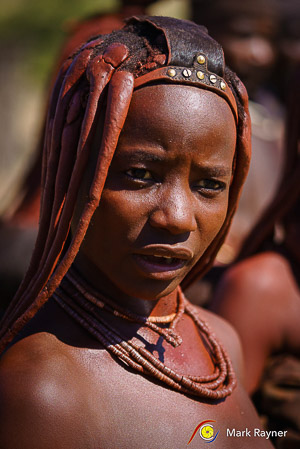


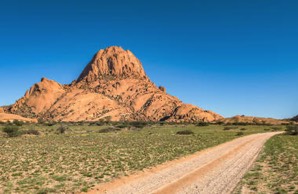




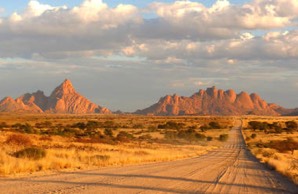
After an early breakfast you will be treated to an exciting 4x4 excursion along the ephemeral Aba Huab River valley to explore this remarkable region and to search for game, especially the elusive desert adapted elephants, if they are in the area. Damaraland is home to a variety of desert adapted wildlife and hidden desert treasures. Depending on their location you will either enjoy a picnic lunch out in the field or return to camp for lunch. This afternoon you visit the nearby attractions and geological sites of Twyfelfontein rock engravings (a UNESCO World Heritage Site, if you have not done so already the previous day.
Overnight: Doro Nawas
Damaraland: Damaraland is typified by displays of color, magnificent table topped mountains, rock formations and bizarre-looking vegetation. The present-day landscape has been formed by the erosion of wind, water and geological forces which have created rolling hills, dunes, gravel plains and ancient river terraces. It is the variety and loneliness of
the area as well as the scenic splendor which will reward and astound you, giving one an authentic understanding of the word 'wilderness'. Damaraland is largely communal land in which wildlife conservancies have been developed to encourage local people to protect and value the animals with which they share this region. Desert adapted wildlife that can be seen include oryx, steenbok, springbok, ostrich, bat-eared fox, cheetah, black rhino and the elusive desert adapted elephant. The ephemeral rivers that traverse the desert plains also create an oasis for other game that browse more vegetated habitats, such as kudu and giraffe.
Desert Adapted Elephant: In habitats with sufficient vegetation and water an adult elephant consumes as much as 300kg of roughage and 230l of water every day of its life. Consider what a herd of them would eat and drink in a week or a month or a year. Finding an African elephant in a desert? Well, yes, and not only elephant, but other large mammals as well, such as black rhinoceros and giraffe. Their ranges extend from river catchments in northern Kaokoveld as far south as the northern Namib. Apart from the Kunene River, seven river courses northwards from the Ugab provide them with possible routes across the desert, right to the Skeleton Coast. The biggest are the Hoarusib, the Hoanib, the Huab and the Ugab Rivers. Desert adapted elephant in Kaokoland and the Namib walk further for water and fodder than any other elephant in Africa. The distances between waterholes and feeding grounds can be as great as 68 km. The typical home range of a family herd is larger than 2,000 km², or eight times as big as ranges in central Africa where rainfall is much higher. They walk and feed at night and rest during the day. To meet their nutritional and bulk requirements they browse on no fewer than 74 of the 103 plant species that grow in their range. Not a separate species or even a subspecies, they are an ecotype unique to Namibia in Africa south of the equator, behaviorally adapted to hyper-arid conditions. Elephant in Mali on the southwestern fringe of the Sahara Desert are the only others known to survive in similar conditions.









Day 11 - Etosha
Drive Damaraland - Etosha NP
Today you bid farewell to granite boulders of Damaraland as you travel towards the richness of the bushveld and the Etosha National Park with your guide. Arrival at Anderssons at Ongava will be in time for lunch and an afternoon game drive on the Ongava Game Reserve starts off your adventure amidst thorny acacias and a myriad of wildlife variety.
Overnight: Anderssons at Ongava
Andersson’s at Ongava: Located just 4.5km from Etosha National Park’s Andersson Gate, Andersson’s at Ongava takes its name from Charles Andersson, the Swedish explorer who first 'discovered' the Etosha Pan with Sir Francis Galton in 1851. Set against a backdrop of the low Ondundozonanandana Mountains, Andersson’s at Ongava is located within the private Ongava Game Reserve which borders the Etosha National Park. The Ongava Game Reserve is typified by white calcrete soils, rocky outcrops and scrub-covered plains which support a rich variety of game such as giraffe, lion, rhino and various antelope species. The Camp overlooks a waterhole where guests can enjoy the interaction of wildlife coming and going throughout the day and night. Central to the design of the new Andersson’s at Ongava is the waterhole and nearby underground photographic hide. Here guests have a water level view of the prolific wild and birdlife on Ongava Game Reserve. A centrally positioned infinity-edge swimming pool and surrounding lounge area allows for relaxing in sheltered nooks with views of the waterhole and beyond. The social area encompasses an undercover and open-air dining area, a spacious lounge and bar, a sunken observation terrace, and open fireplaces to rake away the winter chill. For specialist photographic parties, there is a dedicated photographic nook for review and editing of images. Completing the camp are features such as a uniquely Namibian curio shop, library, complimentary Wi-Fi, and connectivity to the research data developed over years of diligent and cutting-edge scientific endeavors on Ongava.







Day 12 - Etosha
Continue your exploration of the southern parts of the Etosha National Park with lunch to be enjoyed back at the lodge. This afternoon you embark on a sundowner on the Ongava Reserve with one of the dedicated lodge guides before returning to freshen up for dinner.
Etosha National Park: Etosha National Park, translated as the ‘Place of Mirages’, Land of Dry Water’ or the ‘Great White Place’, covers 22,270km², of which over 5,000km² is made up of saline depressions or pans. The largest of these pans, the Etosha Pan, can be classified as a saline desert in its own right. The Etosha Pan lies in the Owambo Basin, on the north-western edge of the Namibian Kalahari Desert. Until three million years ago it formed part of a huge, shallow lake that was reduced to a complex of salt pans when the major river that fed it, the Kunene, changed course and began to flow to the Atlantic instead. If the lake existed today, it would be the third largest in the world. Etosha Pan is the largest of the pans at 4,760km² in extent. It is nowadays filled with water only when sufficient rain falls to the north in Angola, inducing floods to flow southward along the Cuvelai drainage system. The Park consists of grassland, woodland and savannah. There are game-viewing centers around the numerous springs and waterholes where several different species can often be seen at one time. The Park boasts some 114 mammal and over 340 bird species. Wildlife that one might see includes elephant, lion, giraffe, blue wildebeest, eland, kudu, gemsbok (oryx), zebra, rhino, cheetah, leopard, hyena, honey badger and warthog, as well as the endemic black faced impala.
Overnight: Anderssons at Ongava
Ongava Game Reserve: The Ongava Game Reserve is effectively a private game reserve, spanning 30,000 hectares along the south-west border of Etosha National Park. The reserve is home to a wide variety of game including lion, leopard, giraffe, rhino, Hartmann’s Mountain zebra, gemsbok (oryx), kudu, steenbok and much more. The scenery is attractive with large open plains blending into Mopane tree woodlands and dolomite outcrops.


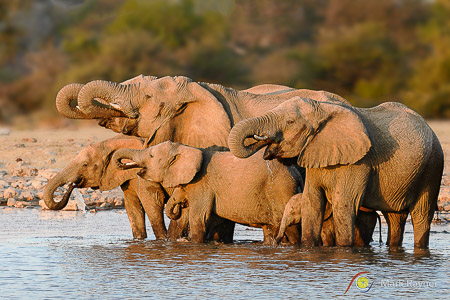
Day 13 - Etosha
Today is spent game-viewing in the Etosha National Park from the comfort of your safari vehicle as you make your way through the breadth of the National Park, stopping at selected waterholes to observe the game gathered there along the way. Lunch will be enjoyed at one of the camps inside the park.
You then exit the park through the eastern Von Lindequist Gate to arrive at Onguma the Fort, situated on the private Onguma Game Reserve.
Overnight: Onguma The Fort
Onguma – The Fort: As the heart of the African sun casts mirages on the horizon, you are invited to experience the Fort on Fisher’s Pan. A fort so unique, that today it stands testimony to a journey worth taking, when the dream is big enough. Positioned to give guests unrivalled views of the spectacular Namibian sunset, Onguma The Fort is a unique refuge in this vast landscape. Overlooking the beautiful scarceness of the Etosha Pans, the Fort gently enfolds guests within massive, cool raw walls and uncompromised luxury. This unique lodge comprises eleven, completely private mini-suites and a fort suite – the latter situated within the spectacular 12m high main tower. Each suite offers sprawling views of Etosha and Fisher’s Pan, as a spacious bathroom with both an indoor- and a private outdoor shower. From every corner of your room, wooden decks and sun-loungers invite you to come out and play. Drift away in desert chic as you dissolve into the beautifully decorated surroundings. Elaborate antique African doors, raw plastered walls and elegant furnishing fuse classic African style with a touch Moroccan and Indian themes – creating a world of dreams… At Onguma The Fort the diverse wildlife can be enjoyed from the comfort of your suite, on a sunset game drive or from the main tower – offering unparalleled views of this unique landscape. Zebra, giraffe, lion, a variety of antelope and superb birdlife will accompany you during your stay. Savour relaxing sunset moments in the outdoor pool, as the view invites you to become one with the dream.
After breakfast you bid farewell to the plains of Etosha and travel south back to Windhoek to spend the last night of your safari in the comforts of Galton House. Dinner this evening can either be enjoyed at your hotel, or out at one of the popular restaurants in town with your guide to reminisce about trip highlights and good memories.
Overnight - Galton House
After breakfast and check out you will be met and transferred by road to Windhoek International Airport in time to check in and catch your scheduled international flight.
Photographic Prerequisites:
This amazing photography tour workshop is designed to suit the beginner or serious enthusiast. A digital SLR (Single Lens Reflex) or Mirrors camera is recommended to maximise the photographic opportunities available, however, any camera that has manual functions would also be suitable. Best lenses to bring include a longer zoom or prime for wildlife (100-400, 500 etc.) and wide angled lens for landscape (14-30, 24-70 etc). A sturdy travel tripod is essential.
Includes:
- Accommodation and meals as stated.
- Transportation in luxury air-conditioned safari vehicles.
- Services of a registered and experienced English speaking safari guide (per vehicle - 2 vehicles in convoy) for the duration of the safari.
- All National Park and other entrance fees and excursions as described in above itinerary.
- Mineral water on board the safari vehicle.
- Local beverages excluding imported and premier beverages whilst mobile camping.
- Return airport transfers from / to Windhoek International Airport.
- Welcome pack.
Excludes:
- International flights to and from Namibia and airport taxes.
- Any meals not included in the above itinerary.
- Any entrance fees and excursions not included in the above itinerary.
- All beverages with the exception of mineral water on board the safari vehicle and local beverages whilst mobile camping.
- Laundry (laundry service available at lodges at extra cost).
- Gratuities.
- Items of personal nature (telephone expenses, curios, medicines etc).
Price:
$17952.00 Twin Share
$1800 Single supplement
Enquire now to reserve your spot
Travel Insurance
You must secure travel insurance.
This workshop is limited at 8 participants to ensure your comfort.
